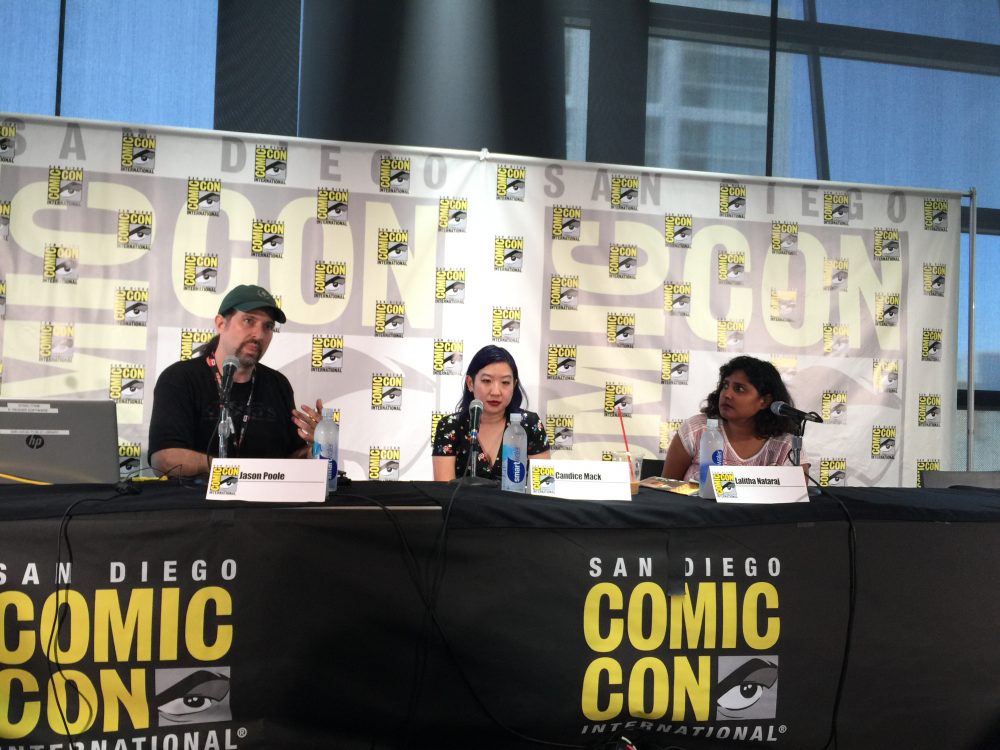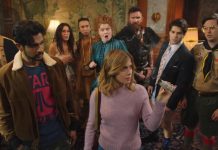By Victor Van Scoit

During San Diego Comic-Con the convention center was busy with cast announcements, trailer debuts, and toy exclusives, while a short walk away some of the best comics talk was taking place at the San Diego Central Library. All weekend long, as part of Comic-Con, panels covered important topics that can easily get lost amongst the Hall H hubbub. That’s why The Beat was there so great panels like Comic Books Are Literacy, Too!, didn’t get lost in media shuffle.
Jason Poole (Webster Public Library and 2016 Eisner judge) served as moderator while Candice Mack (Los Angeles Public Library) and Lalitha Nataraj (Escondido Public Library) rounded out the panel. All of the panelists were experienced librarians who not only love comics, but were there to speak from experience on how comic books had literacy merit. The panel wasn’t going to have much push back, as after Poole asked how many audience members were librarians (public, school, or academic) about 90% of them raised their hands. That didn’t mean the librarians weren’t there to learn anything. Librarians are the unsung advocates and underground tastemakers of the industry and they’ll take every advantage they can to put a comic book in a person’s hand.
Poole began by addressing that even with comic books continuing to grow in mainstream popularity, there are still challenges of establishing that comic books are literacy. Often times parents might hesitate in looking to comic books as reading material because they want their children to read real books too. Poole often has to explain that “Comics are real books too actually.” He continued, “Parents are reluctant because they’re not educated, and they don’t know the breadth of subject that comics cover as well.”
Mack acknowledged the difficulties and also noted how important it is to explain comic books offer literacy in more than just reading. “There’s a lot of exposure to dialogue, particular for English language learners.”, Mack said. Mack added to her argument, “There was one girl in particular who really enjoyed manga, because she was an English language learner. Even if she didn’t understand or read the entire dialogue, the expressiveness of the characters’ faces helped her decipher the thought and context.”
Comic books and graphic novels are tools that can be used to engage readers on several levels. Sometimes that requires building a visual literacy when it comes to reading comic books, and not becoming frustrated in how to approach them. “It’s because it’s a skill and you have to learn how to read comics just as you have to read prose text. [A read then learns], ‘It’s not something inherent in the format that I can’t connect with, but it’s because I’m not as familiar with the format.'”
Mack brought up an interesting analogy to a famous poet. “Part of the fun in reading and exploring comics is deciphering all the little details and hopping around—almost like e.e. cummings poetry. He broke free of the standard just using text and type. That’s one of the great things about comics—to play with layouts and breaking through that fourth wall.”
Poole added to the point by saying, “Even for kids who are good readers comics can be good for them. You can have something above their reading level, but you have pictures that are going to help figure out what the words mean.”
Dr. James Bucky Carter’s example of using Chris Claremont’s X-Men run to build vocabulary was then brought up. “You have Colossus, and he’s this big giant metal guy. You get a really good sense of what the word colossus means and that’s a good 10-cent word. Banshee’s power is screaming. You have these characters that embody the vocabulary words that they are. That’s something that’s a fun way to learn new words, in addition to the contextual clues,” said Poole.
Comic books don’t only serve for early and reluctant readers. Adult literacy is an area where comic books and graphic novels can aid. Adults learning to read want to be taken seriously. With today’s graphic novels they offer opportunities to be on trend, while still learning key concepts. Nataraj explained, “Idioms, homonyms, homophones—you can see that clearly in the play between text and pictures. For that reason comics are wonderful.”
Poole did remind everyone to make sure to evaluate the comic books and graphic novels they choose to recommend, even after a certain visual skill set and literacy have been acquired. “There are a lot of comics that are a lot more advanced in terms of content and layout. If anyone has read any JH Williams III, you have to have some familiarity of the format to follow what’s going on.” Poole expounded on Williams’ artistry, “He might have a tree in the center with the branches spreading out, and the panels will be the spaces in between the branches. It’s very complex the kind of layouts he does.”
The panel took a moment to ask the audience who had read Scott McCloud’s Understanding Comics. Surprisingly only about 5% of the audience raised their hands. The panelists then made sure to offer additional resources to the audience.
The librarians continued to back up their case for comics as literacy when they brought up reluctant readers. That comic books offered yet another option to engage them, whereas prose text alone can not do. Nataraj shared a personal story that had a bit of irony when you consider her role as a librarian. “My son was a very reluctant reader, which was very shocking. It turned out the right books for him was comics. Incredibly I’ve seen a transformation. I don’t always get to know what happens with the other children who come into my library—I get a sense. But with my own son I see him reading the comics. The comics have encouraged him to tell his own stories, so now he will draw and he will write. That’s kind of the magic with the art form and text—it really does spur the imagination and engages the reader.”
Librarians are the kind of advocates that publishers should love and support as they educate prospective readers. But sometimes even librarians can only do so much. What’s a librarian to do in those situations? Nataraj recommended leveraging the power of shiny medals if it can get a book in a readers hands. “In the last couple of years or so, three graphic novels have received those hallowed medals we like to give out. I will shamelessly pull out those books and say ‘Look, here’s El Deafo [The Newbery Honor Award] it has a medal on it, Roller Girl [The Newbery Honor Award], and then the Tamaki cousins’ This One Summer [Caldecott Honor, Printz Honor] is recognized for its literary and artistic excellence. That’s when you can hook the parents.”








The pictures help children understand the words? What words? Comics have been steadily dumbed down for more than 20 years by using the fewest words possible. They are told strictly with dialogue. Virtually all captions have been eliminated. I bought a comic book graphic novel a couple years ago which adapted a section from a regular novel and it had one caption every 3 pages so that you’d never know it originated from a novel. Modern adaptations of Ray Bradbury and H.P. Lovecraft are told with dialogue only even though Bradbury and Lovecraft used the texture of language to tell their stories and create atmosphere, all of which is lost in the adaptations. When Stephen King wrote a comic book for Marvel a few years ago he include captions to establish setting and mood but the editor at Marvel told him they don’t do that any more, so they hired author Stephen King and told him not to use so many words, even though that’s what his fans buy his books to read. Modern comic books have very little in common any more with reading comprehension. For many years people kept trying to say that comics are like movies, but they weren’t. They were a synthesis. but they are a lot like movies now. Readers complain that they pay $4 or $5 for a comic book and can read the whole thing in five minutes. That’s what comics are now. They seem to be aimed at people with short attention spans–people who don’t like to read.
Comments are closed.